Cards In This Set
| Front | Back |
 Details for the following image: Age, Creator, Type of vessel, Description |
Exekias. Achilles and Ajax Playing Dice. c.540-530 B.C.Attic black figure amphora from Vulci. Height: 24″ (61cm). Museo Gregoriano Etrusco, VaticanExekias was both painter and potter, thus signed.In the black-figure technique of Greek vase painting, figures were painted using slip which turned back when the vase was fired. The red background is the unslipped area of the ceramic surface. A stylus was used to scratch through the slipped surface to create details in red - the complex, delicate, deftly incised patterns on the cloaks worn by Achilles and Ajax in this image testify to Exekias’ genius. Although engaged in a game of dice (Achilles calls out “tesara” [four] and Ajax calls out “tri” [three]), both heroes sit poised for action, holding their spears at the ready.
|
 Details for the following image: Age, Creator, Type of vessel, Description |
Exekias. Dionysus in His Boat. c.540 B.C.Interior of an Attic black figured kylix. Diameter: 12″ (30cm). Staatliche Antikensammlungen, MunichDionysis relaxes in his boat after having frightened off a band of pirates by causing grape vines to spring up. The pirates, after jumping overboard in fear, are turned into dolphins. Suitably, this stroy about the god of wine decorates a kylix, or drinking cup
|
 Details for the following image: Age, Creator, Type of vessel, Description |
Exekias. Castor & Pollux return - the heavenly twins. c.540-530 B.C.Attic black figure amphora from Vulci. Height: 24″ (61cm). Museo Gregoriano Etrusco, VaticanExekias was both painter and potter, thus signed. Dioskouroi return home to parents Ledaand Tyndareos. Slave boy brings a change of clothes for Kastor, Pollux, who as already shed his travelling clothes, plays with the family dog.Inverse echinas. Stepped foot or base.
|
 Details for the following image: Age, Creator, Type of vessel, Description |
The François Vase, a milestone in the development of Greek pottery, is a large volute kraterdecorated in the black-figure style which stands at 66cm in height. Dated at circa 570/560 B.C.E. it was found in 1844 in an Etruscan tomb in the necropolis of Fonte Rotella near Chiusi and named after its discoverer Alessandro François; it is now in the Museo Archeologico at Florence. It bears the inscriptions "Ergotimos mepoiesen" and "Kleitias megraphsen", meaning "Ergotimos made me" and "Kleitias painted me", respectively - early evidence that the roles of potter and painter had become separate at this date.The uppermost frieze, on the neck of the krater, depicts on side A[1] the Calydonian Boar Hunt, including the heroes Meleager, Peleus, andAtalanta. The scene is flanked by two sphinxes which are separated from it by a band of lotus blossoms and palmettes. On the other side of the vessel, this zone features the dance of Athenian youths led by Theseus who is playing the lyre, standing opposite Ariadne and her nurse.The second band on side A shows the chariot race which is part of the funeral games for Patroclus, instituted by his friend[2] Achilles, in the last year of the Trojan War. Here, Achilles is standing in front of a bronze tripod, which would have been one of the prizes, while the participants include the Greek heroes Diomedes and Odysseus. On side B, the painted scene depicts a battle of the Lapiths and Centaurs. The most famous of these conflicts took place at the wedding party of Pirithous and Hippodamia, which is probably depicted here, as the hero Theseus is found among the combatants, a friend of Pirithous who himself was not a Lapith, but said to be among the wedding guests. The scene also includes the demise of the Lapith hero Caeneus.The third frieze on both sides, the highest and also most prominent one because of its location on the top of the body vessel, depicts the procession of the gods to the wedding of Peleus and Thetis. Because of its large number of figures, the procession is a suitable topic to decorate the long band. The end of the procession shows Peleus between an altar and the house where Thetis can be seen sitting inside. He is greeting his teacher, the centaur Chiron, who is heading the procession together with the divine messenger Iris, followed by many other deities.The fourth frieze on side A depicts Achilles’ ambush on Troilus outside the gates of Troy, side B shows the return of Hephaestus to Olympus. Hephaestus, sitting on a mule, is led to the Olympian gods by Dionysus, followed by a group of silens and nymphs.The fifth frieze shows sphinxes and griffins flanking lotus blossom and palmettes ornaments and panthers and lions attacking bulls, a boar, and a deer.On the foot of the vessel, there is on both sides a depiction of the battle between the Pygmies and the cranes.The handles are decorated as well, showing on their outer sides the so-called Mistress of Animals above a vignette showing Ajax carrying the dead Achilles. The fields on the inner sides of the handles above the rim of the pot each feature a Gorgon in motion.
|
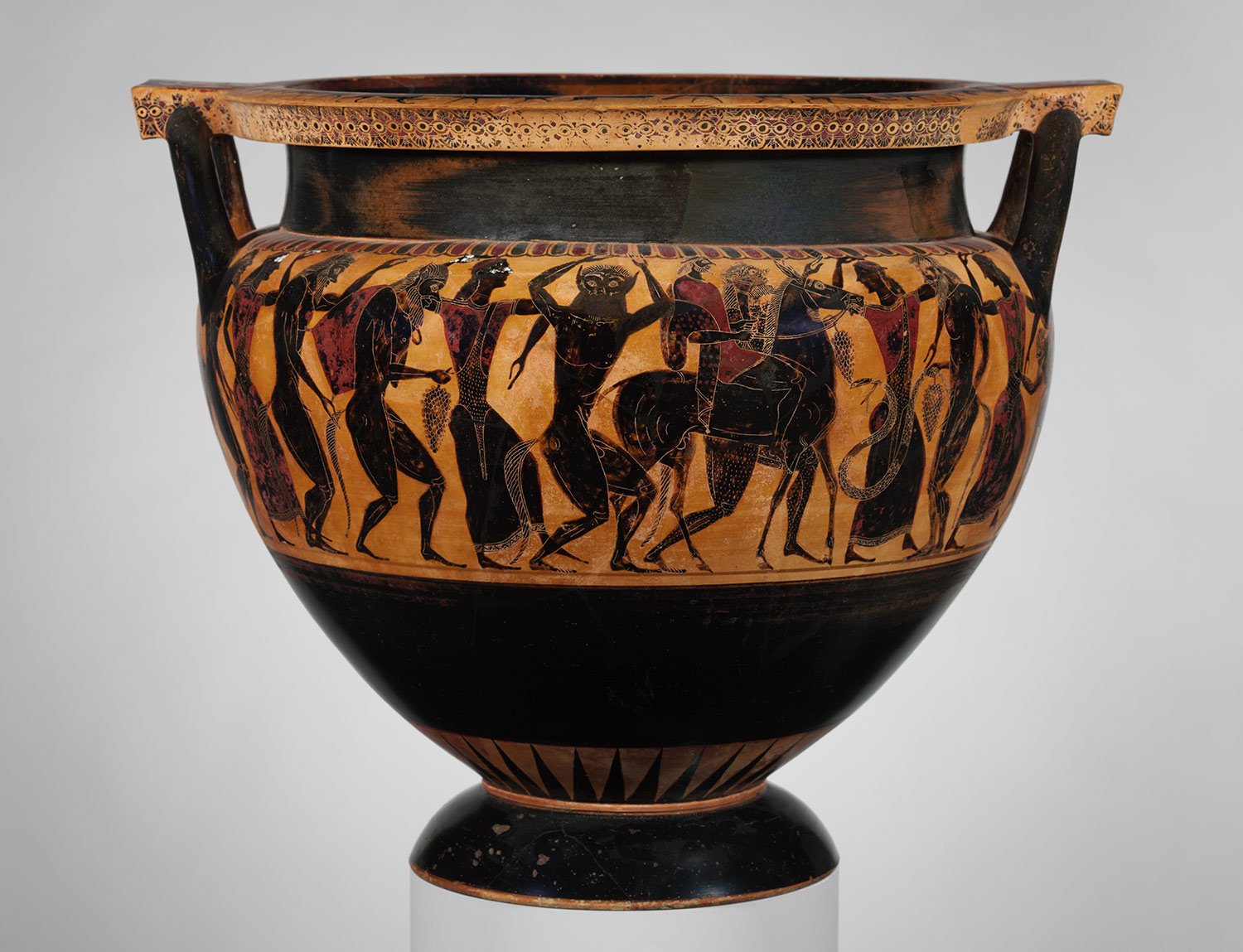 Details for the following image: Age, Creator, Type of vessel, Description |
Column-krater, ca. 550 B.C.; black-figure
Attributed to Lydos Greek, Attic Terracotta H. 22 3/16 in. (56.39 cm) Fletcher Fund, 1931 (31.11.11) Obverse: Hephaistos on a mule among satyrs and maenads Reverse: Dionysos among satyrs and maenads |
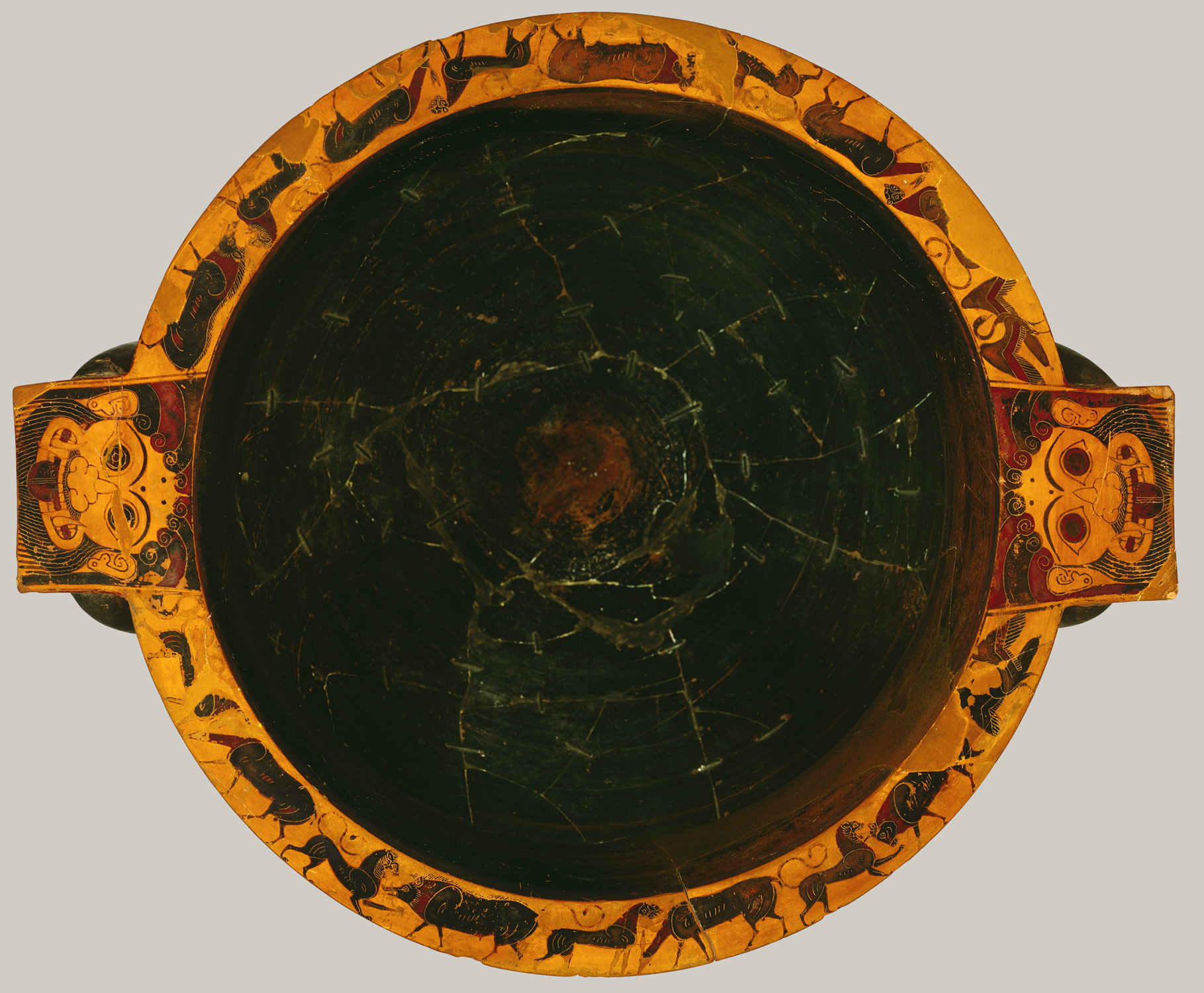 Details for the following image: Age, Creator, Type of vessel, Description |
Column-krater, ca. 550 B.C.; black-figure
Attributed to Lydos Greek, Attic Terracotta H. 22 3/16 in. (56.39 cm) Fletcher Fund, 1931 (31.11.11) Obverse: Hephaistos on a mule among satyrs and maenads Reverse: Dionysos among satyrs and maenads |
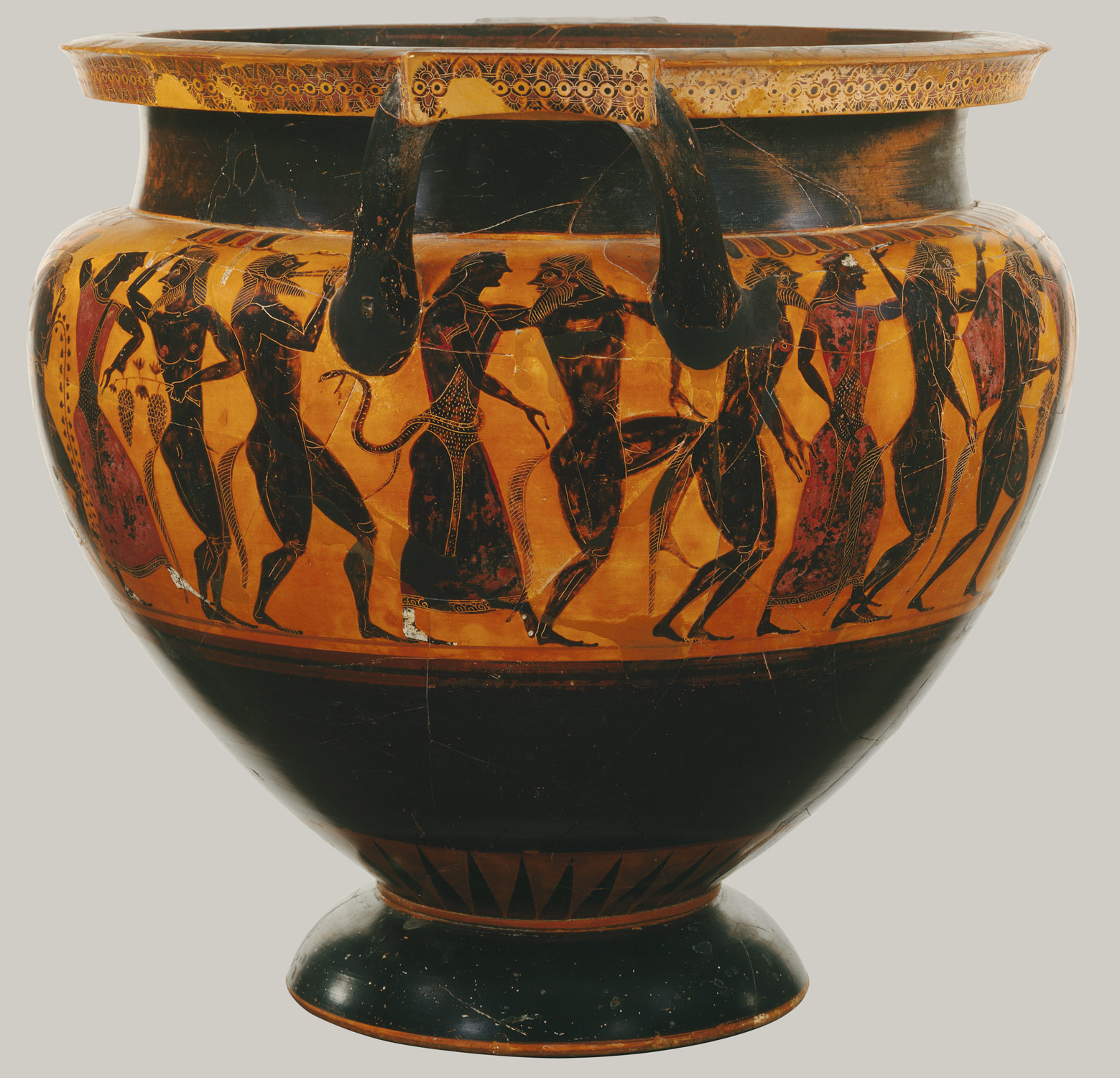 Details for the following image: Age, Creator, Type of vessel, Description |
Column-krater, ca. 550 B.C.; black-figure
Attributed to Lydos Greek, Attic Terracotta H. 22 3/16 in. (56.39 cm) Fletcher Fund, 1931 (31.11.11) Obverse: Hephaistos on a mule among satyrs and maenads Reverse: Dionysos among satyrs and maenads |
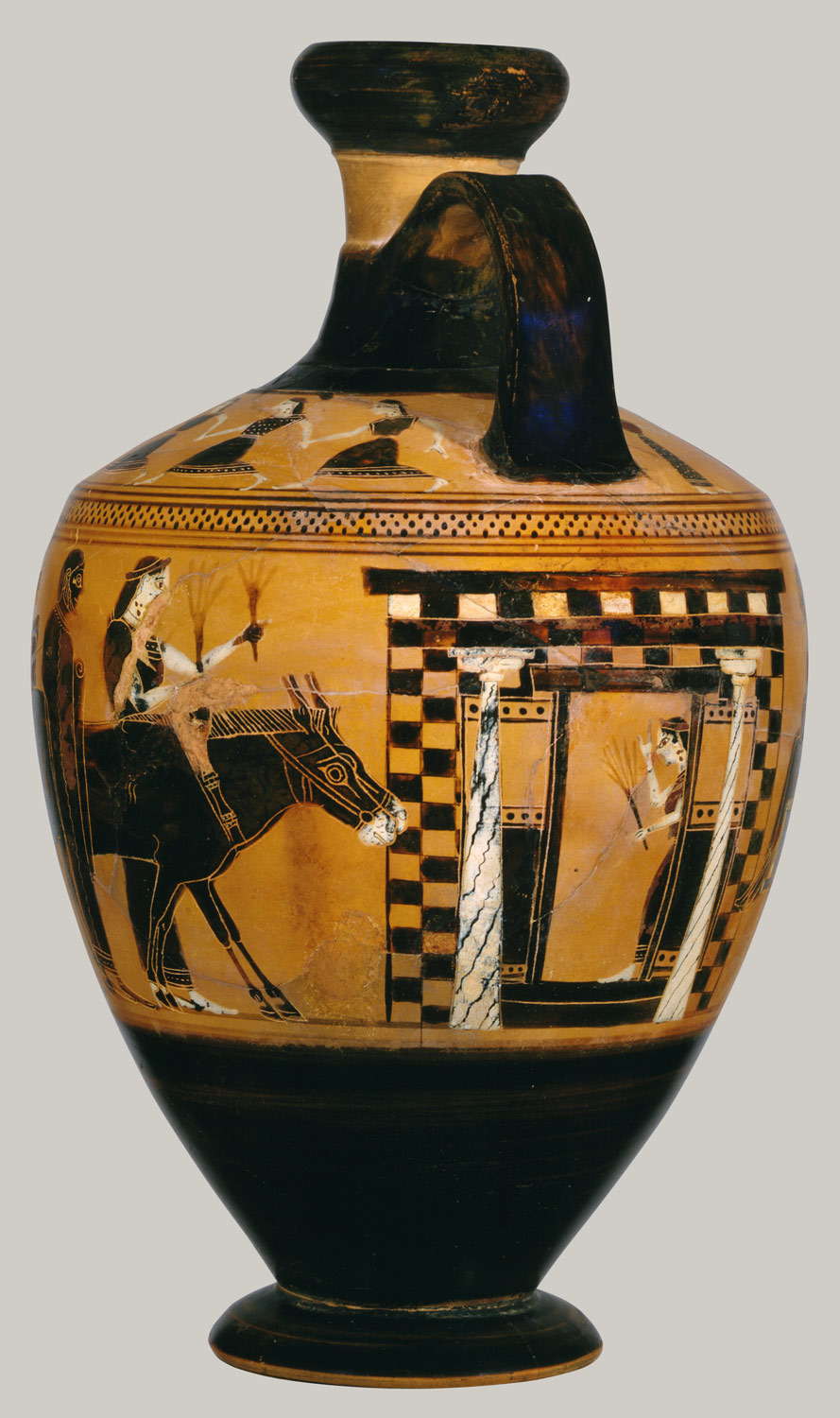 Details for the following image: Age, Creator, Type of vessel, Description |
Lekythos, ca. 550 B.C.; black-figure
Attributed to the Amasis Painter Greek, Attic TerracottaH. 6 7/8 in. (17.50 cm) Purchase, Walter C. Baker Gift, 1956 (56.11.1)The scene that decorates the body of this small lekythos (oil flask) is our earliest and most complete representation of an Attic wedding. The bridal couple and the best man, the parochos, are seated in the foremost cart, which is drawn by two donkeys, distinguishable by their white muzzles and stringy tails. Four guests, all men, follow in a second cart drawn by two mules. Beside each team, two women and a man walk in the procession, with the women on the left and the man on the right. The lead woman holds two torches, which indicates that the wedding procession, as was the tradition, took place at night. The bride holds a wreath and pulls her veil forward in a gesture associated with marriage in Greek art. Her bridegroom sits next to her, holding the reigns; he has a beard and must be much older than the bride, as was the custom in ancient Greece.The procession has almost reached its destination–a brightly painted doorway flanked by two Doric columns just under the handle of the vase. This is the bridegroom's house, the place where the newlyweds are going to live. The doors are open and behind the entrance stands the bridegroom's mother, who carries a torch and raises her hand in a gesture of welcome. The bridal procession, the critical point of passage between the bride's home and that of the groom, was the most conspicuous public part of a wedding ceremony in ancient Attica. Torches and songs added to the festive occasion when the bride's mother, torch in hand, led the couple to their new home.The shoulder of the lekythos is painted with a subsidiary scene of a dance: three groups of three women dance in a chain that is separated by a musician playing the aulos and another playing the lyre. In the Iliad, Homer describes an aulos and lyre that accompanied the wedding dance. In ancient Attica, both men and women danced at the wedding, but in separate groups well within view of each other. |
 This vase is by a potter you have researched - what are the interesting details about this pot that it would be useful to know. |
Heracles and Ares fight over the corpse of Cycnus, in the lower register an animal frieze, signed by the potter Kolchos, attributed to the painter Lydos, Attic wine jug, c. 560 BC, found in Vulci, now in the Berlin Collection of Classical Antiquities, Altes Museum
|
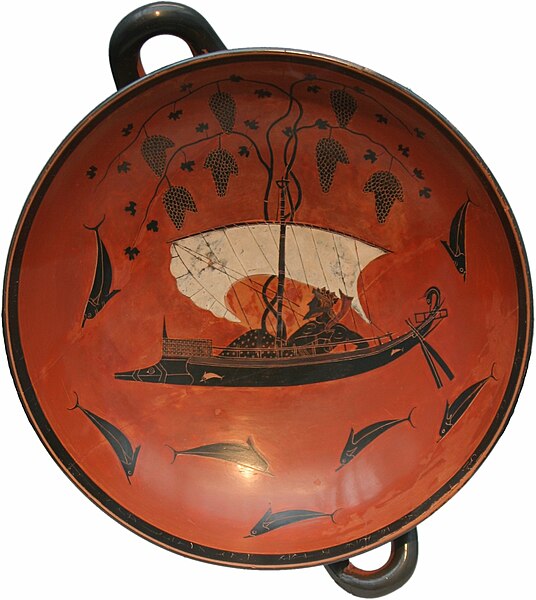 Details for the following image: Age, Creator, Type of vessel, Description |
EXEKIAS
One of his most famous works is the so called Dionysos cup (Munich, Antikensammlung 2044). The cup falls into the category of eye cups and is decorated on the outside with two pairs of eyes. Unlike other examples of this group, figuratice scenes are filling the space at the handles, probably an innovation by Exekias. The interior shows a depiction of the god Dionysos on top of a coral-red slip, which coated the entire picture-space. The Dionysos kylix uses the bottom of a wine bowl as a working surface for the main scenario. Dionysos was the god of inspiration. The painting depicts the initial journey of Dionysos to Athens by ship. Pirates had seized the ship and were going, perhaps, to sell Dionysos into slavery. Instead the god caused vines to grow from the mast, frightening the pirates so much that they jumped overboard and were changed into dolphins. |
 Details for the following image: Age, Creator, Type of vessel, Description |
EXEKIAS
One of his most famous works is the so called Dionysos cup (Munich, Antikensammlung 2044). The cup falls into the category of eye cups and is decorated on the outside with two pairs of eyes. Unlike other examples of this group, figuratice scenes are filling the space at the handles, probably an innovation by Exekias. The interior shows a depiction of the god Dionysos on top of a coral-red slip, which coated the entire picture-space. The Dionysos kylix uses the bottom of a wine bowl as a working surface for the main scenario. Dionysos was the god of inspiration. The painting depicts the initial journey of Dionysos to Athens by ship. Pirates had seized the ship and were going, perhaps, to sell Dionysos into slavery. Instead the god caused vines to grow from the mast, frightening the pirates so much that they jumped overboard and were changed into dolphins. |
 Details for the following image: Age, Creator, Type of vessel, Description |
Ajax prepares for his suicide. Reproduction of the scene on the Exekias amphora, original c. 530/525 BC
|
 Details for the following image: Age, Creator, Type of vessel, Description |
Attic red-figure calyx-krater, clay, painted by Euphronios, vessel: 18" h, c. 515-510 B.C.
(Metropolitan Museum of Art, New York): |
 Details for the following image: Age, Creator, Type of vessel, Description |
Attic red-figure calyx-krater, clay, painted by Euphronios, vessel: 18" h, c. 515-510 B.C.
(Metropolitan Museum of Art, New York): |
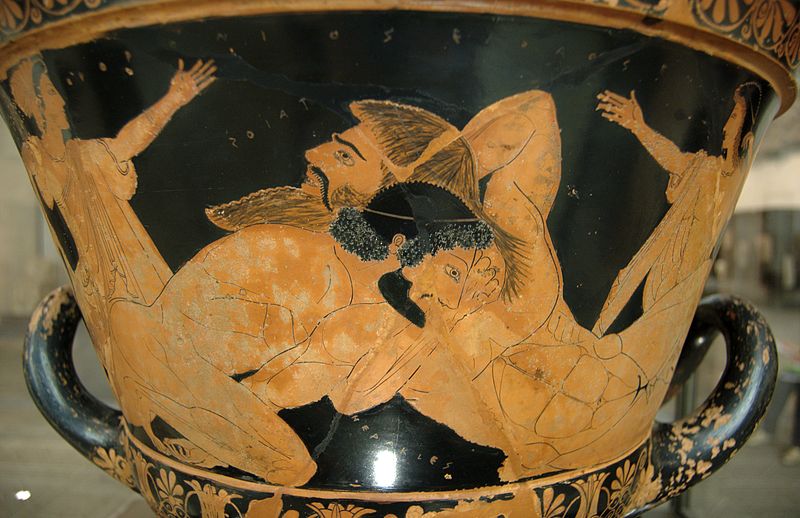 Details for the following image: Age, Creator, Type of vessel, Description |
Museum Collection: Musée du Louvre, Paris, France
Catalogue Number: Louvre G103 Beazley Archive Number: 200064 Ware: Attic Red Figure Shape: Krater Painter: Signed by Euphronios Date: ca 515 - 505 BC Period: Late ArchaicSUMMARYHerakles wrestles the Libyan giant Antaios, grasping him in a neck lock. The two women may be the daughters of the giant. The calyx, as was stated earlier, was used for mixing water with wine for revelers at parties, usually held in private residences. Euphronios, as he painted it, separated it into basically four parts: the first being the base, the second a bulging strip taking up most of the bottom third of the bowl right underneath the main, flat third section of the calyx, and the fourth being the lip of the calyx. A masterpiece of Greek pottery, this calyx-krater by Euphronios, known as the "Krater of Antaeus," is one of the most elegant Attic red-figure vases ever produced. The detailed rendering of the muscles of the bodies in combat is precise and original. The realism of Antaeus's face is equally innovative. The monumental group is highlighted by the divergent composition of the women fleeing in the background. The red-figure technique appeared in Attica in around 530 BC and sounded the death knell of the black-figure technique. The first ten years were a period of exploration. Then, around the 520s, a group of unique painters known as the "Pioneers" emerged. It included Phintias, Euthymides, and in particular Euphronios. Eclectic, curious, and innovative, they worked with potters like Cachrylion and Euxitheos to form a group of imaginative and audacious precursors who shared their discoveries. Liberated from the rigid frameworks of their predecessors, they filled the space of the vase by painting bodies in more natural postures, giving them volume and introducing foreshortening to create a kind of perspective. The musculature is rendered in precise anatomical detail, thanks to the use of a diluted glaze in light brown tones. The same naturalism characterizes the treatment of the folds of the fabrics. They also invented new vase forms, like the stamnos, the pelike, and the amphora with twisted handles. Euphronios began his career as a painter around 520 BC and was active for twenty years. During the first three decades of the 5th century BC, he worked as a potter. His final works—some cups painted by the Pistoxenos Painter—date from around 470 BC. The hero and the giant Euphronios painted both mythological compositions and scenes from daily life. Both types of decoration coexist on this vase. Side B shows a music competition, with a young man holding an aulos mounting a platform amid his seated companions, while on side A the battle between Heracles and the giant Antaeus is taking place. The hero's weapons—the club, quiver, and lion skin—are suspended in the field. Antaeus, the son of Poseidon and Ge (the Earth), is identified by an inscription. We are at the end of the battle: Antaeus was drawing his strength from contact with the Earth. To weaken him, Heracles has lifted him up before suffocating him. The body of Antaeus is drawn in a position of abandonment. His right hand is already limp, devoid of strength, and his face is marked by the effort. His half-open mouth shows his teeth in a rictus of pain. His iris, in the upper part of his eye, also underlines the fact that the end is near. Heracles, still bent over in a dynamic position, reveals nothing of the effort he is making. The different treatment of their hair and beards emphasizes the opposition between the two figures: Heracles' are neat, with the curls surrounding his face perfectly drawn with beading; Antaeus's are tousled and painted in coarse brushstrokes, while his moustache and eyebrows are heavily accentuated. The painter has done this to highlight the major difference between the hero of the civilized Greek world and the barbarian giant. The women in the background are drawn on a smaller scale, thereby creating a perspective that accentuates the importance of the two bodies. |



